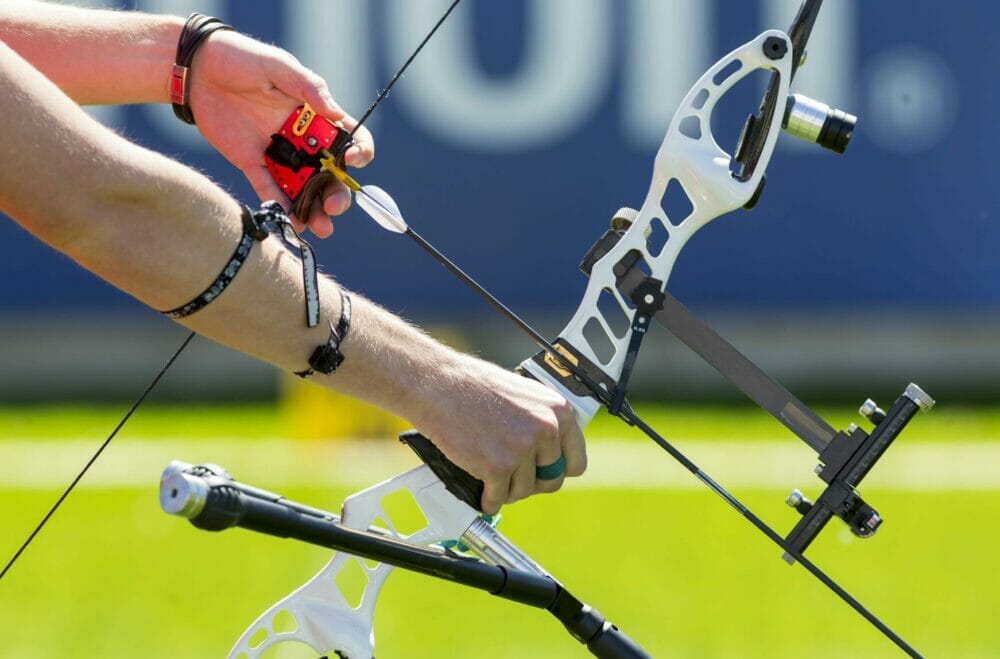As with any different type of bow, compound and recurve bows are both great for different purposes. If you are looking at getting a new bow, or even your first ever bow, then you might be wondering about which one you should get.
Both of these bows come with their own set of advantages and disadvantages, and the type that you get will depend on the intended use of the bow.
It can be difficult to choose between the two if you aren’t sure exactly what they are best for, which is why we are going to explain everything you need to know about each of them in this article.

What is a Compound Bow?
A compound bow is a bow that features a levering system that is typically made of cables and pulleys, and these work to bend the limbs. Compound bows are widely used in both target practice and hunting, and the pulley system actually gives the user a mechanical advantage.
The limbs of a compound bow are much stiffer than those of a recurve bow or a longbow, and this rigidity helps to make the bow more energy-efficient. This is because less energy will be dissipated in the limb movement.
It will also work to improve overall accuracy as it will reduce the sensitivity to changes in temperature and humidity of the bow.
What is a Recurve Bow?
A recurve bow is a bow that has limbs that will curve away from the archer when it is unstrung. A recurve bow will store much more energy and deliver energy really efficiently than any straight-limbed bow.
This gives it much more energy and speed for the arrow. Recurve limbs will put more stress on the materials that have been used to make the bow, so they will make more noise with the shot.
Are Compound Bows Easier to Draw?
A compound bow is much easier to aim than a recurve bow as the string forces at full draw will be reduced due to let-off. It is also a smaller bow that is more adjustable, and when it has been fully drawn, you won’t have to hold back all of the force that is stored within the bow.
When you release the string when using a compound bow, the cams will unwind and accelerate the string faster than the weight that you were holding. This effect that occurs from this reduction in forces is known as let-off. So, compound bows are easier to draw.
Should I Get a Compound or Recurve Bow?
A recurve bow is one of the best that you can get for survivalists and hunters, but mastering this type of bow will often take lots of practice and persistence. However, most people enjoy this challenge as it makes things more interesting.
You will need more technique to use this bow in comparison to a compound bow. As well as this, they are also usually much lighter, which makes them easier to carry, providing the perfect advantage if you are out hunting.
However, like with all other traditional bows, a recurve bow will not have the mechanisms that compound bows have. This means that they will rely entirely on your own strength, and they also require a lot more force to draw.
In turn, this means that you are going to need some good upper body strength to be able to handle a recurve bow. You will also need to move closer to the target, which takes even more technique and talent. These reasons are why these bows are typically used by those with more experience.
Compound bows will still require practice to be able to use them efficiently, but they are not as complex as recurve bows. This is due to the fact that they do not rely on your physical strength as much, and they also allow for better accuracy and power from a greater distance.
So, things like stealth and concealment are going to be less important than they would be if you were using a recurve bow. Additionally, compound bows allow for more customization, and they are often made to accommodate more tools.
However, this type of bow also features some disadvantages, like how the bow’s draw is set, so you will have to make sure that you size your bow correctly when it comes to choosing the right one for you. Compound bows are also typically fairly heavier and bigger than recurve bows.
Something that some people might consider to be a disadvantage is the fact that the compound bow has a more modern feel, which may not be best suited to everyone. This means that stringing, tuning, and maintaining your bow is going to require more skill.
Essentially, the more complex your bow is, the more technical these things are going to be.

